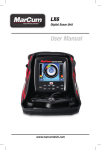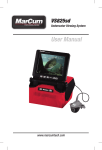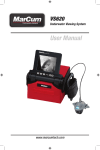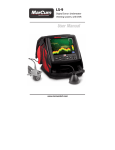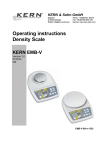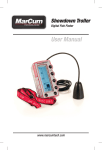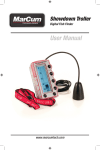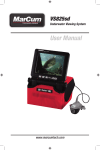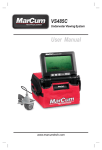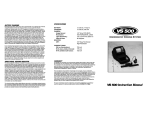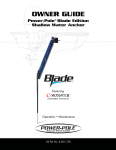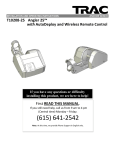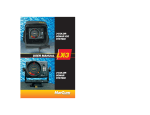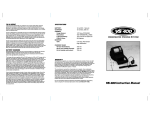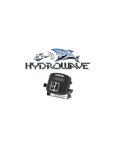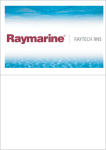Download User Manual
Transcript
LX7 Digital Sonar Unit User Manual www.marcumtech.com Versa Electronics www.marcumtech.com Table of Contents Introduction. . . . . . . . . . . . . . . . . . . . . . . . . . . . . . . . . . . . . . . . . . . . . . . . . . . 3 Features. . . . . . . . . . . . . . . . . . . . . . . . . . . . . . . . . . . . . . . . . . . . . . . . . . . . . . 3 Getting Started . . . . . . . . . . . . . . . . . . . . . . . . . . . . . . . . . . . . . . . . . . . . . . . . 3 Ice System Set-Up. . . . . . . . . . . . . . . . . . . . . . . . . . . . . . . . . . . . . . . . . . . 3 Operation. . . . . . . . . . . . . . . . . . . . . . . . . . . . . . . . . . . . . . . . . . . . . . . . . . . . . 4 Control Panel . . . . . . . . . . . . . . . . . . . . . . . . . . . . . . . . . . . . . . . . . . . . . . . 4 Zoom. . . . . . . . . . . . . . . . . . . . . . . . . . . . . . . . . . . . . . . . . . . . . . . . . . . . . . . 10 Cone Angle Info. . . . . . . . . . . . . . . . . . . . . . . . . . . . . . . . . . . . . . . . . . . . . . . 11 Interpreting Signals. . . . . . . . . . . . . . . . . . . . . . . . . . . . . . . . . . . . . . . . . . . . 11 How To Decide Which Configuration To Use. . . . . . . . . . . . . . . . . . . . . . 13 Tips For Using Your Lx-7. . . . . . . . . . . . . . . . . . . . . . . . . . . . . . . . . . . . . . . . 14 Charging The Battery . . . . . . . . . . . . . . . . . . . . . . . . . . . . . . . . . . . . . . . . . . 15 Some Common Sense Safety Tips: . . . . . . . . . . . . . . . . . . . . . . . . . . . . . 15 To Charge Your Battery:. . . . . . . . . . . . . . . . . . . . . . . . . . . . . . . . . . . . . . 15 Open Water Application . . . . . . . . . . . . . . . . . . . . . . . . . . . . . . . . . . . . . . . . 16 Two-Year Warranty . . . . . . . . . . . . . . . . . . . . . . . . . . . . . . . . . . . . . . . . . . . . 16 How To Obtain Service. . . . . . . . . . . . . . . . . . . . . . . . . . . . . . . . . . . . . . . . . 17 -2- Versa Electronics www.marcumtech.com Introduction Congratulations on purchasing the Marcum LX-7 Digital Sonar—the most advanced ice sonar system available. When Marcum was founded over a decade ago, we all knew that our original flashers were just the beginning. Every step of the way, we have been designing, improving, building momentum. This momentum keeps us in nearly perpetual motion, on the Vanguard of innovation, with our competition forever in our rear-view mirror. We’re glad you’ve joined us in the front seat. While our existing product lines have always beat the competition in every category, up until now there has always been room for lively discussion as to the merits of various systems. These discussions will now come to a stop as we usher in a new era in ice fishing electronics: The LX-7. The LX-7 is the most advanced ice fishing sonar ever designed, now that you own one you’re about to see why. What makes the LX-7 tick? The LX-7 Digital Sonar takes DNA from other fine Marcum sonars –you might say it was “bred” for excellence. Because the LX-7 is digital, we can pack it full of more features than have ever been found in an ice sonar before. With an 8" customizable dashboard display, superior target separation, 12-level interference rejection, dual-beam transducer, expandable zoom, and much, much more, the LX7 is the perfect combination of macro features and micro precision. FEATURES •8” LCD Monitor—No Fishfinder is easier to see •Dual Beam Transducer—Quickly switch between 20 degree and 8 degree •Rugged transport shuttle with extendable transducer arm •Padded nylon soft pack offers the ultimate in protection •Protective clear shield •12 volt 9 amp battery with automatic 3-stage charger •2 year warranty •User-friendly fully adjustable zoom •Dashboard Display keeps the angler updated with critical information •Five different sonar windows to choose from, display up to three at once •Silent operation GETTING STARTED Ice System Set-Up Your LX-7 comes virtually ready to fish. Remove the LX-7 from the packaging and place on a level surface with the MarCum Technologies logo facing towards you and right side up. Open the top cover of the soft pack by lifting up on the Velcro closures on each side and front of the soft pack. Once -3- Versa Electronics www.marcumtech.com opened, loosen the knobs on the either side of the gimbal bracket (at the base of the monitor) by turning each one counter-clockwise. Make sure to loosen the knobs a considerable distance. The monitor can now be positioned how you want it. Once the monitor is positioned how you want it, tighten the knobs again to hold the monitor in place. The front panel of the soft pack can be folded up and secured behind the monitor with the hook and loop fasteners. Hook up the LX-7 power cord to the battery by plugging the pigtail lead into the receptacle on the wiring harness coming off the battery. Your LX-7 is delivered with a 9 amp battery that is charged, so you can take it fishing right away. Even though the battery comes charged, if you are not going fishing immediately, you should hook up the charger anyway to make sure the battery has a full charge. To charge the battery, see below. The LX-7 will operate for 10 hours or more on a fully charged battery. If you are going to be in situation where you will want to use your system for more than one day without recharging, having a second, fully charged battery with you is cheap insurance that will ensure you will be able to get full use out of your system for the duration of your trip. Inside the LX-7 deluxe softcase is an electronics shuttle that has compartments for the battery and the dual beam transducer, as well as the transducer arm. The adjustable transducer arm allows for maximum flexibility in positioning the LX-7 around the ice hole, and can even be moved to the other side of the shuttle. Using the LX-7 can be as simple as turning it on—the factory settings will come on automatically and allow you to use the LX-7 in the most popular configuration. Be sure to explore all of the options available to customize your Dashboard Display. With five different sonar portals, four color palettes, 2 cones angles, and a myriad of other settings, there are many possibilities. It is easy to explore these options, and you can set the LX-7 so that it defaults to your preferred arrangement. Changing your settings is easily done on the fly, but experimenting while using the simulator at home will help you learn the “flow” of the menu and settings. OPERATION The LX-7 has many functions and settings that are selected or changed by buttons on the Control Panel. Learning what each of the buttons (POWER, SENS, RANGE, ZOOM, IR, CONE ANGLE, TARGET ADJUST, MENU/ENTER, UP, DOWN) does will enable you to get the most out of your LX-7. Note that you can experiment with different settings and dashboard arrangements in SIMULATOR mode. Many of the selections will activate just by highlighting your desired setting. Control Panel The following is an explanation of each button on the control panel and what it does. Some of the button functions can also be accessed in the main menu. Pressing any of the Control Panel buttons will cause a window to open, enabling the user to make the desired adjustments. All button function windows will time out after about 10 seconds. Any changes made to the settings will activate when the MENU button is pressed, or after a few seconds without activity. -4- Versa Electronics www.marcumtech.com POWER - Press and hold this button for 2 seconds to turn your unit on or off. SENS - The SENS (sensitivity) button controls the amount of sensitivity required by the unit to pick up objects like bottom, weeds, fish, smaller bait-fish, or small lures and jigs. The lower the number, the less sensitivity, conversely higher numbers mean more sensitivity. To adjust your sensitivity, first press the SENS button and a bar will appear at the bottom of your display. Pressing the UP/ DOWN will adjust your sensitivity, and the sensitivity setting will now be digitally displayed on the SENS gauge. The best SENS setting is achieved by turning up your sensitivity from 0 until you receive a clear and steady bottom reading. To see your lure or bait, turn up the SENS some more until you just begin to display your bait without it fading or flickering on the screen. The sensitivity will go up to 25, but a setting between 5 and 10 is likely to be where you want it set in most instances. Too much sensitivity will only display with unnecessary information, showing clutter and making it more difficult to interpret the return signals. Clutter can be caused by any number of suspended items, including algae, zooplankton, tiny bubbles, and other particles. RANGE— The LX-7 is equipped with “Auto Range” and “Dynamic Depth”. The LX-7 will automatically lock onto the proper range with either of these settings. There are also 9 manually adjustable depth ranges—10, 20, 40, 60, 80, 120, 180, 240 and 300-feet. If you manually select a range, select a range that is deeper than the actual depth and when in doubt, error on the “deep” side. Regardless of the depth range setting, your LX-7 will always display digital depth, even if the bottom is deeper than the bottom limit of the RANGE setting (down to 300’). To change your range setting, press RANGE and scroll up or down using the UP/DOWN Buttons. When the desired range is highlighted, press MENU to instantly change, or just wait for a moment and the LX-7 will lock into the selected range automatically. AUTO RANGE— The LX-7 has an Auto Range feature that allows you to simply turn on the unit and begin fishing. To enter Auto Range, press RANGE. This will open a window with 11 range options. Now use the UP button to highlight “Auto”. Now press MENU, and the LX-7 will automatically lock into the appropriate depth range. For instance, in 32 feet of water, the LX-7 will lock into the 40 foot range. In 45 feet of water the LX-7 will automatically lock into the 60 foot range. Your Range gauge will show an “A”, and the needle will be all the way to the left. DYNAMIC DEPTH – This Marcum exclusive feature functions similarly to the “Auto Range”, but fine tunes your range even farther. The Dynamic Depth will maximize the space on your display by utilizing a constantly variable range that will always be just slightly deeper than the actual depth. For example, if you were fishing in 23 feet of water, the Dynamic Depth range will be 25 feet, if you were in 29 feet of water, the Dynamic Depth range will be 32 feet. The Dynamic Depth range will not go shallower than 10 feet. MANUAL RANGE— To manually adjust the LX-7’s depth range, press RANGE. This will open a window with 9 range options. Now use the UP or DOWN button to highlight whichever range you would like to be in. The LX-7 will lock in your selected range as soon as the selected range has been highlighted. -5- Versa Electronics www.marcumtech.com ZOOM—The ZOOM button allows you to select the upper range of the portion of the water column you would like to zoom in on. The actual size of the Zoom window can be adjusted in the Main Menu. The Zoom feature allows you to focus the display on a specific depth within the water column, and can be a great benefit in a variety of fishing situations. See the separate ZOOM section below for more info on the ZOOM. Whenever you are utilizing the zoom menu, keep in mind that the menu will “time-out” after 10 seconds. IR (INTERFERENCE REJECTION)— The Interference Rejection system is designed to suppress competing return signals from other sonar units being used within close proximity. When other sonar units are causing interference to the display of the LX-7, activate the IR feature by depressing the IR button located on the control panel of the LX-7. Interference is indicated by unusual signals flashing or scrolling across your display. There are 12 levels, or channels, of interference rejection. Press the IR button once to open the IR window, now use the UP/DOWN buttons to select the desired level of IR. The correct level of IR will be achieved when the display is clear of display clutter. In some extreme cases, clutter will be greatly reduced but not totally eliminated. Anytime two or more sonars are being operated in proximity to each other, there is the potential for interference. Deep water and hard bottom will increase the likelihood that one or more of the competing sonars will experience interference. Besides experimenting with different levels of IR, the anglers experiencing interference can also try having their transducers set at different levels, going to narrow cone angles, and reducing gain or sensitivity settings. CONE ANGLE— All transducers send down a signal that is shaped somewhat like a cone. Your LX-7 easily switches from a 20 degree cone angle (good for general use) to a narrow 8 degree cone angle (good for water over 40', or any time you need a more precise view of what is below you). See the special section on Cone Angles below for more info. A feature unique to the LX-7 is the “Sonar Footprint” that displays the actual extent of coverage by your transducer while you are fishing. This data is displayed below the cone angle icon, and represents the diameter of the base of the transducer cone. This will keep you constantly updated how much area is being covered by your LX-7, and will help you decide which transducer angle best suits the conditions. When the LX-7 is first turned on, it will be transmitting utilizing the 20-degree setting. To switch from 20 degree to 8 degree, simply press the CONE ANGLE button once and use the UP/DOWN buttons to highlight the desired selection. The cone angle changes as soon as you highlight a selection and the Sonar Footprint will change with it. TARGET ADJUST— This feature allows the angler to change the size of the signals being displayed without increasing the sensitivity. Depending on the angler’s preference, the signal size can be easily changed from a razor thin line to a thicker band. The TARGET ADJUST feature will give you the thinnest, smallest, signal size at “0”, and the signals displayed will get thicker as you -6- Versa Electronics www.marcumtech.com increase the TARGET ADJUST. This feature should be used in conjunction with the SENS to fine-tune your display. Anglers who have a hard time seeing, as well as those who fish from a standing position will really appreciate the “TARGET ADJUST” feature. BATTERY METER—This gauge indicates the voltage currently being produced by your battery. The LX-7 needs between 11 and 13 volts to properly operate. If the voltage drops below 11 volts, you may see a decrease in performance. Recharging your battery after each use will maximize the life of your battery, and will ensure that your LX-7 will run strong all day. MENU/ENTER— This button enables you to access other functions of the LX-7. Some of these functions are also accessible through the use of the other buttons on the Control Panel. When you press the MENU button, three sub-menus will be revealed—SONAR SETTINGS, DISPLAY OPTIONS, and SYSTEM SETTINGS. Use the arrow buttons to highlight the desired sub-menu, and press MENU again to access to the sub-menu. SONAR SETTINGS is the first sub-menu, and it has the following features that may be adjusted: SENSITIVITY This adjusts the sensitivity. This is described in the Control Panel section above RANGE Select range in the same manner as described above ZOOM DEPTH Here is where you set the upper range of the zoom window. This can also be done by using the ZOOM button as described above. The actual size of the zoom window is adjusted in the “Zoom Window” field. ZOOM WINDOW Here is where you determine the size of the Zoom Window. Go to the “Zoom” section of the manual for more specific information. IR Interference Rejection can be adjusted here, as well as by using the Control Panel button. See above for more info. TARGET ADJUST Target Adjust can be adjusted here, as well as by using the Control Panel button. See above for more info. CONE ANGLE Cone Angle [and Sonar Footprint] can be adjusted here, as well as by using the Control Panel button. See above for more info. SONAR MODE Choose between “ice fishing” and “open water” mode here MAX PING RATE Adjusting this setting will increase the response time of signals from your transducer to the screen. If fishing shallow water (less than 20 feet) use the lower settings. Likewise, you will see better performance with the higher settings in deeper water. -7- Versa Electronics www.marcumtech.com DISPLAY OPTIONS is the second sub-menu, and it has the following features that may be adjusted FLASHER DISPLAY The Flasher Display can be turned on or off here VERTICAL DISPLAY The Vertical Display can be turned on or off here VERTICAL ZOOM DISPLAY The Vertical Zoom Display can be turned on or off here CHART DISPLAY The Chart, or Scrolling graph, can be turned on or off here CHART ZOOM This enables you to use the scrolling graph in zoom mode GAUGE DISPLAY Your 5 gauges, as well as your Sonar footprint may be turned on or off here TEMPERATURE Your water temperature display may be turned on or off here. You may also select between Fahrenheit and Celsius here. This feature will only work if you are using your unit with the optional “Universal Sonar”, designed for open water use. BACKLIGHT You can adjust the overall brightness level of the display here. When using outside during bright conditions, you will want to have it set fairly high, at 50 or more. In low light or when using inside an ice shack, a setting of 50 or less is desirable. COLOR PALETTE There are four different color palettes; you choose which one you prefer here. See the section below on Color Palettes below for more info. BACKGROUND There are three different backgrounds; you choose which one you prefer here. The “Night” option is great for low light periods or when in a darkened shack. SYSTEMS SETTINGS is the third sub-menu, and it has the following features that may be adjusted LANGUAGE Choose between English and French UNITS Depth can be displayed in feet or meters SIMULATOR The LX-7 has a simulator mode that will portray a variety of different depths and signal returns. Activating this feature enables the user to experiment with the various settings without actually being on the water. This simulator represents an open water experience, so the depths and signals will change as it goes through the simulation. -8- Versa Electronics www.marcumtech.com RESTORE FACTORY This is where you can restore factory settings. The factory settings are the most popular configuration, and if at any time of changing your selections you want to revert back to this screen, you may easily do so here. RESTORE SAVED If you find a screen configuration that you like, you can easily return to that saved screen by highlighting this selection SAVE This is where you can save your favorite screen configuration. When you turn the LX-7 on, it will power up to your last screen displayed. You can now change it to the original factory settings by highlighting “Restore Factory”. While out fishing, you may find a particular screen configuration that you like. Access “System Settings”, highlight “Save”, and press MENU. You may now move through other screen configurations, but come back later by pressing “Restore Saved”. Turning the LX-7 off will set that screen configuration as “Saved”. COLOR PALETTES Use this feature to choose which of the 4 color palettes you prefer. Option 1, Option 2, Option 3, Option 4 The default setting has RED as representing the strongest signal, often signifying a hard bottom or a larger fish that is in the center of the transmit signal (cone). GREEN represents a softer bottom or smaller fish in the middle of the transmit signal or a larger fish on the outside of the transmit signal. YELLOW represents weaker signals and often signifies weeds, small bait-fish, medium-sized fish on the outside of the transmit signal. When using the other color palettes, the colors displayed and the signal strengths represented will change accordingly. SIMULATOR— The LX-7 has a simulator mode that will portray a variety of different depths and signal returns. Activating this feature enables the user to experiment with the various settings without actually being on the water. This simulator represents an open water experience, so the depths and signals will change as it goes through the simulation. GAUGES— A feature unique to the LX-7 is the ability to be able to constantly see where your most critical settings are at. At a glance, you will be able to tell what your Sensitivity is at, what level of IR you are operating at, how high your Target Adjust is, your range, and battery status displayed in volts. The gauges can be turned on or off by pressing MENU, highlighting “Gauge Display”, and making your selection. Where the gauges display will depend on which screen configuration you have selected. -9- Versa Electronics www.marcumtech.com ZOOM One of the best features to have in an ice fishing Sonar is a “Zoom”, and there is none better than that of the LX-7. A Zoom feature enables you to have a magnified view of a selected portion of the water column. Note that when the ZOOM window is open, you can still view the entire water column on one of the other windows. Imagine that you are fishing for walleyes in 30 feet of water, and you are zoomed in on the bottom 5 feet. If a school of crappies comes through at 20 feet, you will be able to easily see them on one of the other windows, and quickly raise your bait to their level. The position of the ZOOM window is adjustable in one-foot increments. The ZOOM can focus on bottom (for detecting bottomhugging fish), or at any level above bottom. The LX-7 also offers Auto Bottom Track Zoom that automatically zooms and locks onto the bottom, even when you change locations. This is especially useful for if you are hole-hopping for bottom hugging fish like walleyes and perch. To access the Auto Zoom, press ZOOM, and then press the UP button until “A” (Auto) appears. It will appear after you pass “0” on the Zoom Window. The ZOOM feature on the LX-7 can be accessed in several ways depending on which sonar windows you have displayed on your dashboard. Having your LX-7 set at the factory default setting for a screen configuration will make it easiest to learn how to use the Zoom. It is highly recommended that you learn how the Zoom works while in simulator mode. Operating the Zoom is quite simple, and only requires the pressing of a few buttons to select the size and position of your Zoom Window. So, start by having the factory default screen (Flasher in center, Vertical Display on left, Vertical Zoom on right) open. The area that is featured on the Zoom Display is indicated by the “Zoom Indicator Bar”, a light blue bar on the right side of the Vertical Display. When you press the ZOOM button, a “Zoom Depth” window will appear at the bottom of the screen. This is where you set the uppermost limit of the Zoom Display by pressing the UP/DOWN buttons. When you have the desired depth highlighted, pressing ZOOM again will establish that depth as the top of your Zoom display. You will notice that the Zoom Indicator Bar will move up or down as you make these adjustments. To set the size of what is shown in the Zoom Display, press MENU, and then highlight “Zoom Window”. You can now select which size zoom window you want. Going through this process several times before you go fishing is a great idea, as that will allow you to easily and quickly make adjustments right away once on the water. If you have only the Flasher Display, the Vertical Display, or the Scrolling Graph Display open, and go into zoom mode, pressing the “ZOOM” will cause the vertical zoom window to appear, and a “Zoom Depth” window will open at the bottom of the screen. You will still set the uppermost limit of your zoom window here, but you won’t have the advantage of having the Zoom Indicator Bar to show you exactly what area is being highlighted. With a little bit of experience, you’ll find this to be quite easy to do. Just set the zoom depth for 5, 10, 20, or 40 feet above the bottom, and then set the Zoom Window to the size that is appropriate. - 10 - Versa Electronics www.marcumtech.com For example, if you were fishing in 30 feet of water, and wanted to zoom in on the bottom 10 feet, press ZOOM, and then set the zoom depth for 20 feet (10 feet off bottom). Now press MENU, highlight “Zoom Window”, and select 10 feet. The 20 to 30 foot portion of the water column is now displayed on the Zoom display, and the entire water column is viewable on the flasher window. The LX-7 also features “Chart Zoom” which enables you to use a scrolling graph in Zoom mode. Activate the Chart Zoom in the Display Options of the menu. You set the zoom just as you would when using the other sonar options. When you press the ZOOM button to make a change, the Vertical Zoom window will automatically open. After adjustments have been made, you may turn the Vertical Zoom window off again in the Display Options of the menu. CONE ANGLE INFO A feature unique to the LX-7 is the “Sonar Footprint” that displays the actual area being covered by your transducer while you are fishing. This data is displayed below the cone angle icon, and represents the diameter of the base of the transducer cone. This will keep you constantly updated how much area is being covered by your LX-7, and will help you decide which transducer angle best suits the conditions. When the LX-7 is first turned on, it will be transmitting utilizing the 20-degree setting. To switch from 20 degree to 8 degree, simply press the CONE ANGLE button once, and the CONE ANGLE icon will change from 20 degree to 8 degree, and the Sonar Footprint will change with it. Conditions where the narrow beam will benefit you are: 1—Fishing in deep water (over 40’) for walleyes, perch, or lake trout 2—Fishing along very steep drop-offs for bottom-hugging walleyes 3—Fishing in big schools of fish, like suspended crappies or tullibees 4—Fishing in and around heavy weeds for panfish, like bluegills and crappies 5—Fishing in a crowd, the narrow beam will reduce interference from your neighbor INTERPRETING SIGNALS DIGITAL DEPTH— The digital depth display on the LX-7 provides a quick and easy way to determine depth. Digital Depth is always displayed in the center of the circular display, and on the bottom of the vertical displays. It will also show in the upper left corner of the graph in some configurations. This display can be used as a quick reference when checking depths through the ice. READING BOTTOM— When interpreting your bottom signal, always read the leading edge (shallowest side) of the signal return. If you have a strong signal return (wide band) and it starts at 13 feet and ends at 16 feet, the correct depth is 13 feet or the shallowest leading edge of the return signal. Anything beyond the shallowest leading edge indicates the strength of the return signal. Your LX-7 can also be used to determine bottom composition. The thicker and bolder your bottom shows, the harder the bottom is. In some cases, hard - 11 - Versa Electronics www.marcumtech.com bottom can be indicated by a “double” or second echo that will show on your display at approximately twice the water depth. Soft bottom (silt, mud, muck) will only register one bottom reading. Using your Sonar in conjunction with an underwater viewing system is a great way to learn how to interpret your sonar signals. READING FISH— Fish will generally appear as separate targets from the bottom. Using the factory default color palette, a fish target can be displayed as RED, GREEN, or YELLOW, depending on the size of the fish and the location within the transmit beam. Larger fish located in the center of the beam (cone) can appear RED and will be displayed as a wider band on the display. Smaller fish or fish on the outside of the cone may appear green or even yellow. Fish moving through the transmit beam may change color as the return signal strengthens or weakens reflecting their location. Some fish, like walleyes, are notorious for cruising right on the bottom. The LX-7 has target separation fine enough that it will generally show bottom hugging fish as a separate signal. However, fish that are right on the bottom can appear as part of the bottom. The best indication of a fish sitting right on the bottom is that the leading edge of the bottom return signal is either GREEN or possibly a dithering or flickering RED segment. It is important that the sensitivity be kept to a minimum when displaying a strong bottom return. Having your sensitivity too high will flood out the ability to differentiate targets and clutter the display. Utilizing the ZOOM feature can give you a magnified look at the bottom when this is happening, and help you better learn what is going on below you. Schooling fish, like crappies or white bass, will sometimes group in large numbers suspended off the bottom. A big school of fish concentrated in one portion of the water column can show on your sonar as one large “blob”, and it can be difficult to pick out individual targets. Zooming in on the zone with the most fish will give you better definition, and switching to the 8 degree cone will eliminate signals from fish on the periphery of your area, improving your definition even more. READING LURES AND JIGS— The LX-7 will pick up and display the smallest of lures and jigs. When tuning the unit to display your lure, lower the object to the desired depth and turn up the SENS until you see the lure or bait on the display. It is important that the SENS be set so it displays the lure or bait as you raise or lower it. Once you have the SENS set where you want it, you can finetune your signals by using the TARGET ADJUST button. NOTE: When tuning the unit to display lures or bait, make sure that the objects are in the center of the hole and therefore in the center of the transmit beam. If there is current (some lakes and all rivers have underwater current or movement) and the lure doesn’t weigh much, it may move to the outer edge of the signal or out of the transmit beam altogether. This will make it difficult or impossible to pick it up on the display. The LX-7 has sensitivity that will enable it to display the smallest ice jigs, as well as sinkers and swivels, at all depths. The target separation of the LX-7 is down to ½". This means that two objects that more than ½” apart can show as two - 12 - Versa Electronics www.marcumtech.com separate signals on your display. If you have a strike and fail to hook the fish, you can even determine if you still have bait on your jig, or if you have to reel up and re-bait based upon how the signal appears. Dead Zone - All sonar units will have a dead zone in certain circumstances. This occurs on sharp drop-offs where the transmit beam (cone) hits the shallower edge of the drop-off and returns before the deeper edge returns. This in effect creates an undisplayed area between the shallower and deeper water within the transmit beam. The 8 degree transmit option on the LX-7 will greatly reduce this effect. How To Decide Which Configuration To Use With 5 different sonar windows, along with a plethora of other settings, it can be hard to decide on which one to display. If you have used traditional mechanical flashers in the past, you may like the familiarity of the LX-7’s flasher display. The flasher displayed with one or more of the vertical display is likely to be how most anglers use the LX-7, at least for starters. We get endless feedback on how well the scrolling graph display works for ice fishing, so be sure to give it a try. Be sure to experiment with different color palettes and backgrounds, too. CIRCULAR [FLASHER] DISPLAY— This Sonar window will read much like a traditional flasher-style display. You can set the range manually, or allow the Auto Range or Dynamic Depth Interface to automatically lock into a RANGE that will optimize the use of the circular display. Signals are displayed as various colored lines on the dial, and the different colors represent different signal strengths. VERTICAL DISPLAYS— These Sonar Portals are very easy to interpret—top is the top, bottom is the bottom. Anything in between the top and bottom is weeds, fish, or your lure. There are two different Vertical displays—one shows the entire water column, one shows your ZOOM window. On each one, signals are displayed as various colored lines on the column, and the different colors represent different signal strengths. SCROLLING GRAPH (CHART) DISPLAYS— These displays will show not only what is happening below you in real time, but will also enable the user to have a “history” of what has happened. While most commonly used for open water, many anglers are discovering the benefits of using a graph on the ice. The LX-7 stands apart from other graphs in that it displays with ultra-fast “True-Time” sonar response – less than .02 seconds between the echo reaching the transducer and when signal appears on LCD screen. Other graphs experience a much longer response time. When used from a boat in open water, the user will see signals displayed in classic “Graph” fashion; the bottom will be a solid band, and fish or other objects display as “arches”. When used from a stationary position, such as ice fishing, the bottom will display as a solid band, but other signals, like fish or your jig, will display as lines of varying thickness. Always remember that the thicker the band, the stronger the signal. A large fish is likely to display as a fairly thick band, while a - 13 - Versa Electronics www.marcumtech.com small ice jig will show as a very fine line. The best way to learn how to interpret signals on the graph is to have it displayed along with the circular or vertical display. After using the graph along with one of the more familiar displays, you may find that you like fishing with the graph best of all. It is fascinating to watch the “trail” of your jigging motion, and fine tuning your presentation to exactly what the fish want has never been easier. The LX-7 has the option of displaying a full water column graph, as well as an adjustable zoom graph. The interpretation of these signals improves with experience and use in the field. TIPS FOR USING YOUR LX-7 Setting up the transducer for ice fishing: When used in conjunction with the retractable pivoting transducer arm and rubber stopper, the LX7’s transducer will automatically level itself in your ice hole. To begin operation, take the transducer out of the recessed holder, and rotate the adjustable ice arm out from inside the shuttle. Extend transducer arm, (the cable should already be threaded through it with stopper in place) and deploy the transducer into the water. We recommend setting your stopper to have the transducer down the least amount possible. The LX-7 puts out enough power that in most cases it is not necessary to have your transducer down more than a few inches below the water line to get a good reading. When the ice thickness is over two feet, it may be necessary to have your transducer set farther down. Remember--the less transducer cable you have out, the easier it is to pull it out of the water when bringing in a fish, or to move to a new location. Moving the LX-7 to a new location— Being mobile is one of the keys to being successful on the ice. Whenever you move from one spot to another, it is tempting to leave your transducer hanging on the transducer arm. This is likely to lead to failure of the transducer arm, and can cause damage to the transducer itself if it is allowed to drag on the ice. Always stow the transducer inside the pack when you are moving. Keeping the amount of transducer cord you have out at a minimum will make transporting your LX-7 easier. Similarly, you may need to quickly remove your transducer from the hole when about to land a fish. We have actually seen anglers in a panic actually grab the shuttle itself and toss the entire unit to the side. This is no way to treat any piece of electronics; a much better approach is to simply lift the transducer out of your way by the cord, and the shuttle itself can be gently pushed aside. When moving from hole to hole, your LX-7 can be easily carried by the nylon handle. Whenever you are moving via sled or vehicle, always fold up your transducer arm, stow the transducer inside, and close the protective soft pack. - 14 - Versa Electronics www.marcumtech.com CHARGING THE BATTERY Your Marcum system comes with a 3-stage battery charger. This style of charger has proven to be the most effective and easiest to use of all charging systems available. While the rate of charge is low, a completely discharged battery can be brought back to a full charge in as little as 12 hours. Because this is a 3-stage charger, there is no danger of overcharging your battery. When properly cared for, a sealed lead acid battery will last for at least a couple of years. Batteries are made to be used, and they need to be used to make the most of them. The most important thing you can do is to promptly recharge your battery after each use. Not charging your battery immediately after use is the number one thing that leads to battery failure. When you get home from a trip, put your battery on charge right away, and leave it there overnight, or for around 8-12 hours. We often talk to people who hesitate to charge their battery after each use for fear that the battery will develop a “memory” and this will lead to a shortened run time—THIS IS FALSE!!! ALWAYS CHARGE YOUR BATTERY AFTER EVERY USE!!! Be sure to use the charger that came with your system, or a similar one that is between .5 amp and 1 amp. Using a larger charger, like you would use on a car, truck, RV, or boat is likely to cause damage to the battery. There is really very little danger of overcharging your battery with a low amp charger, and most chargers automatically go into “maintenance mode” once a full charge has been achieved. A 3-Stage charger works like this— Stage 1 (Bulk Stage): Constant current charging at a high voltage level at maximum amperage to minimize charge time. Stage 2 (Absorption Stage): Current tapers off for final 10% of charge. Stage 3 (Maintenance Stage): Lower voltage mode to prevent electrolyte loss, keeping your battery at full charge indefinitely. Some Common Sense Safety Tips: For safety reasons, it is recommended that you place your system on a flat, hard surface like cement or tile when charging it, away from any flammable materials. Be sure to disconnect the charger from the wall when not in use, and avoid leaving your battery hooked up to the charger for extended periods of time. To Charge Your Battery: Your battery has a wiring harness attached to it that has “piggyback” terminals on it, enabling you to keep the power cord from the unit attached to the battery at all times, as well as having the wiring harness with receptacle for your charger attached at all times. To charge, simply couple the end of the charger with the end of the wiring harness. It is normal for a green light to appear on the charger at this time. Once connected, plug the transformer end of the charger into a 110 volt AC wall outlet. You will see a red LED light appear on the charger at this time. When your battery is fully charged, this - 15 - Versa Electronics www.marcumtech.com red light will change to green. Depending on the condition of your battery, this process can take up to 20 hours to complete. At this time, you can disconnect the charger from the battery and wall outlet. However, no harm will come to your battery if you leave it attached to the charger. If you need to remove the battery, unplug the two battery terminals from the battery. Remove the Velcro strap that is holding the battery in place and lift the battery out. To replace the battery, place a new battery of similar specifications into the battery compartment and secure it with the hook and loop strap and re-connect the positive and negative terminals. OPEN WATER APPLICATION The LX-7 is just at home on a boat as it is in your ice shack. The Universal Transducer [sold separately]is designed to be mounted right to your boat’s transom, or to the lower unit of a bow-mounted trolling motor. This design makes it easy for you to use your LX-7 for high speed scouting work, or for breaking down a piece of structure one piece at a time. The Universal Transducer can transmit an 8 or 20 degree cone, and it also has a temperature sensor. From an anchored or otherwise stationary position, you can use your LX-7 from a boat much like you would on the ice—you can see the fish and how they react to your jig on the screen. Two-Year Warranty Versa Electronics warrants this product to be free from defects in materials and workmanship for two years from the date of purchase. This warranty applies to customers who properly fill out and return the warranty card included with this manual. Failure to complete and return the warranty card voids the warranty. Versa Electronics will, at its sole discretion and without charging the customer, repair or replace any components that fail in normal use. Failures due to abuse, misuse, or unauthorized alteration, modification or repair are not covered. The battery is not covered by the warranty. The warranty is valid only for the original owner who purchases the unit from an authorized dealer. Products purchased from on-line auction sites are not considered under warranty. - 16 - Versa Electronics Versa Electronics 3943 Quebec Avenue N. Minneapolis, MN 55427 RA#__________________ Note: The RA number must be clearly marked on the outside of the package www.marcumtech.com How to Obtain Service We want our products to provide you with a pleasant on-the-water experience. That means maximum customer satisfaction. If you have a problem with your unit please contact Versa Electronics toll free number at (888) 778-1208 for a Return Authorization Number (RA#) or e-mail us at [email protected]. No service returns will be accepted without this return authorization number, which must be clearly marked on the outside of the package. Versa Electronics retains the exclusive right to repair or replace the unit at its discretion. The customer is responsible for shipping costs associated with returning the unit to Versa Electronics. Versa Electronics will pay for shipping the repaired unit back to the customer while it is still under warranty. All out of warranty services will be charged a fee for service and shipping which must be paid in advance. After obtaining a Return Authorization number, the unit should be securely packed and shipped “pre-paid freight” and insured to Versa Electronics. It is the consumers’ full responsibility to track their products sent out in the mail or other forms of delivery service. Versa Electronics will not be liable for lost packages sent out in the mail. Unless specified otherwise, do not include batteries or other accessories when returning the product for repair. Versa Electronics will not be responsible for lost or damaged accessories. Please allow a minimum of 10 business days to complete your repair. ACCESSORIES Soft Pack Shuttle Transducer Arm Ice Transducer 12 v 9 amp Battery Power Cord Battery Charger Snowshield Open water transducers Puck Hi-speed Replacements for these items can be ordered off our website, marcumtech. com or by calling the toll-free number 888-778-1208 - 17 - Versa Electronics www.marcumtech.com OTHER GREAT PRODUCTS FROM VERSA ELECTRONICS Showdown Troller The new Showdown Troller Digital Fish Finder is a palm-sized sonar device with full size performance. For use in either ice-fishing or open water situations…quickly “troll” from hole to hole while ice-fishing or shoot through your canoe or kayak in order to find fish and the correct depth. As a scouting tool it has ne equal; the ultimate in portability is matched to ShowDown’s proven Crystal-Quick® vertical display. The sonar instantly locks on to bottom, and clearly displays the location of fish and your lure, anywhere in the water column. VS825SD The VS825sd offers several technologies that are the first of their kind, making this system the most technologically advanced underwater viewing system available. Using new technology such as an 8” Solar Intelligent- H2D display will deliver the sharpest, most vivid display, even in direct sunlight; Color Kill technology allows you to switch between a Color or Black and White image on demand, while maintaining crisp screen resolution; On-Screen displays of Camera Direction, Depth, Temp and Battery Voltage take all of the guess work out of your camera position so your new VS825sd can be used to hunt for underwater treasures, locate the “spot on the spot”, observe fish in their natural habitat or learn how fish react to your lure or bait presentation. The applications are endless, and it’s never been easier or more fun to view. - 18 - www.marcumtech.com MarCum User Manuals are available for download from www.marcumtech.com.




















